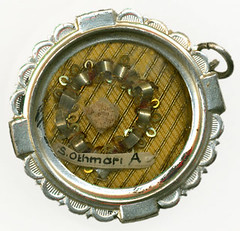One Spring day in Sister Mary Gilmary's classroom.
It was nearing Good Friday and we seventh graders had spent the previous two days reading and discussing the Passion of Christ. There was considerable interest, amongst the boys at least, in the amount of pain that would be felt when the nails went through the hands and feet.
One kid had stepped on a nail the previous summer and told us all about how awful it felt. He said that it was really really awful, but that he didn't blackout and that he was smart enough, the doctor had said, to bring the piece of wood with the nail in it to his house to show his mother.
All of us had been required to write a poem, mine had the nails crying out that they didn't want to be part of the sacrifice and Christ's tears becoming the seeds of faith for millions.
On Holy Thursday, Sister brought a relic for us to see and touch. I don't remember now who's piece of bone is was, but it was in a lovely little glass case. A tiny piece of something on a bit of red felt, Sister said it was an actual piece of bone from the Saint.
We passed it from desk to desk, hand to hand, each of us looking at the small round brownish white dot. Sister was relieved to get it back after it had made the rounds of the room.
Then we walked in two columns down to Saint James Church to have our confessions heard. (1961)

Later, much later, I remember talking to someone who had been horrified to learn that a few soldiers in Viet Nam had kept the skulls and scalps of of people they had killed. I already knew about receiving powers from the bones of the dead so it didn't surprise me.
Joe(hoc est corpus meum)Nation